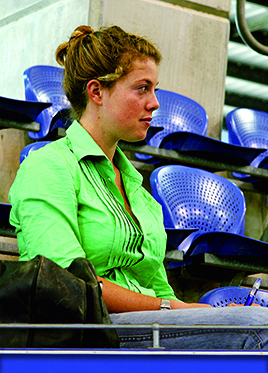
with Alexandra Bruggisser
(this is part 2 – to read part 1 click)
It was one of the highlights of my equestrian year, a clinic with none other than Christoph Hess, the man who helps write the tests we battle through. In the first part we looked at the initial stages of training young horses, this time, we will focus on young riders and their mounts, and in the next, we will see how Christoph approaches training the more experienced horses and riders.
With the spotlight on young riders involved in the clinic, it seems rude not to mention their smug glee as they noted that the older riders at the clinic took longer to adapt to Christoph’s style of teaching than they did, Interesting you might think, ‘slow old coots’ you may even say, but actually, neurologically, it makes sense, and it is a perfect example of why learning and experimenting with different ideas when you are young and your brain is flexible, is so important.
Young riders haven’t reinforced their behaviour as much because they generally haven’t been doing it as long. It’s just another advantage of youth making us more adaptive to change.
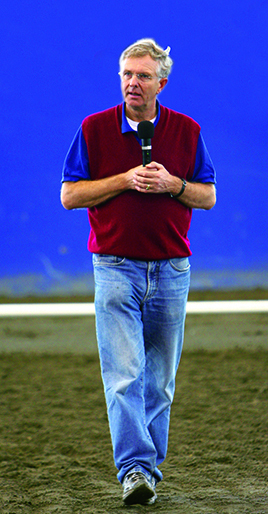
Christoph is an exceptionally friendly character and all the riders releated well to him. As Robbie Soster put it: “Christoph was such a great help for all of use. He made you feel like you could really get somewhere because he was so complimentary.”
Robbie and her nine-year-old imported Hanoverian gelding, Robali Razzamatazz (Rotspon / Wolkenstein II) were first out for the young riders. Robbie usually trains with Miguel Tavora, but she is also lucky have her Mum, Ali, at home as yes on the ground. “Razz is an absolute lad. He’s cheeky and not easy to train, but has that bit of spunk to give him an edge in the dressage arena – when the spunk is heading in the right direction, that is!”
story continues below the advertisement
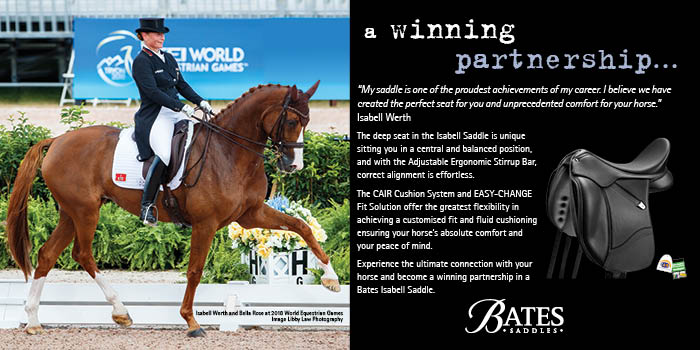
The first message for the attractive combination is simple – more forward.
“Is the horse lazy or not? asks Christoph. “Ahh not too bad. Good, good, ja. Come, come, COME. Ja. that’s it. For me the trot needs to go a little more by itself. He’s a little bit unsteady in the contact. Come, come. Nice mover, okay, for me the horse could work a little bit more by itself. The German word is ziehen (to pull), you have to work to the contact. And just walk, I want to give you a tip. For me he is too lazy, when you come with the whip here” – Christoph taps the hindquarters and Razz moves his leg backwards – “He has the wrong reaction, it is not a forward going reaction. Now we will use the whip here” – Christoph uses the whip on the shoulder and Razz jumps forwards – “you see, it has to be a little more forward. Here at the shoulder there is a better reaction, try it.”
Robbie does so with amazing results and transformation we can see is quite incredible.
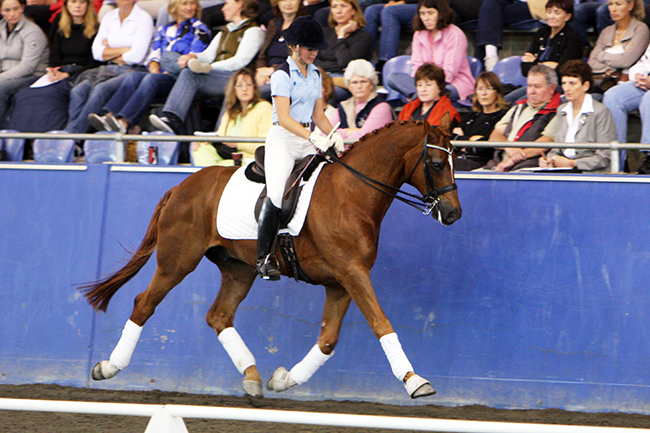
“So! And trot. Rising trot, a little bit at the shoulder. So. So. SOOO! Normally you can use a very short whip and then just tap at the shoulder. SOOO!” Razz canters. “And pat him, pat him. Very good. He has to do a little bit more by himself. Good canter rhythm. Robbie look around a little bit so that you are relaxed and supple in your upper body. And whip again at the shoulder. Sooo!”
“With the young horse I think many riders use the whip not in the right way. They use the whip at the hind leg and then the horses hate it. But if you use the whip at the shoulders you often have a very good reaction. Go and use the whole arena so you can have a little more of a steady contact.”
In the second corner, Robbie uses the whip at the shoulder and Razz tucks his quarters under him and shoots forward.
“Good, ok, no problem. let the horse go. When you have such a reaction you have to be very very careful with your hands. Don’t block the horse in this situation. Good, so, long strides. Super canter, very good under the point of gravity and very good inside hind leg. Come on, use the whip, use the whip once more! And there is a positive reaction, very good. And very soft in this second with your hands, that’s a good way to start with this kind of horse. And again with the whip, when he becomes lazy let him go forward.”
“And Robbie, when you have trouble to stay on the circle, go a little with the inside rein to the inside (gesturing to an opening rein) not backwards, only sidewards. And long stride canter – come on.”
story continues below the advertisement
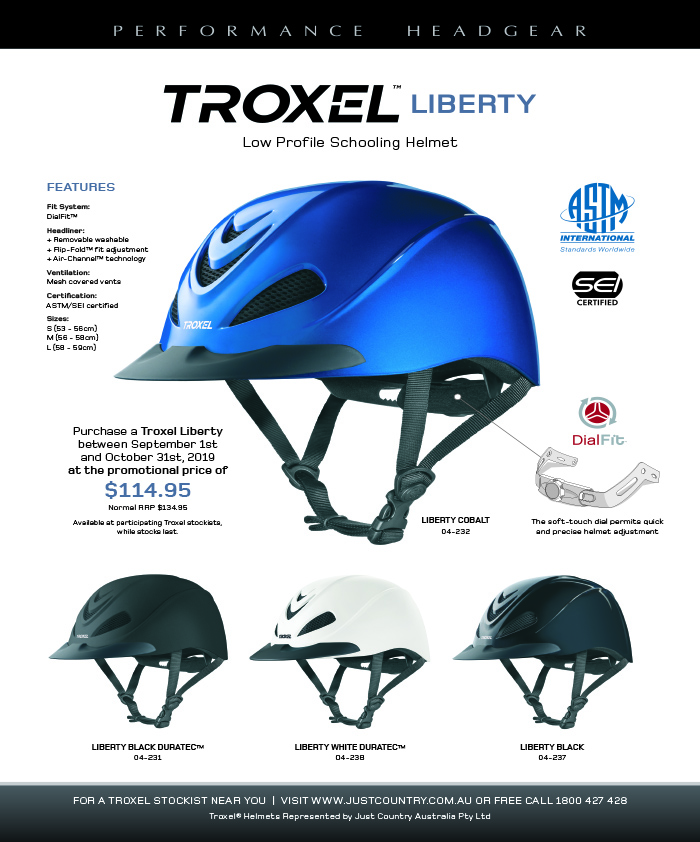
On day two of the clinic, Razz seems to have changed his tune and appears much more forward.
“Sit the trot and canter left. And with long strides we start the canter left. Ja, ja, very good.”
Robbie is also much braver.
“And the next long side, a transition to trot. That’s great. And pat the horse. And then give the long rein and whip again. Long rein and stretching, not long rein and behind the vertical. Then we don’t do a good job, so longer rein and stretching. Sooo, whip again, he has to stretch the neck with a longer rein sooo. And transition to canter.”
Razz starts to run.
“So, once more, no problem.”
This time he pops straight into canter and Robbie pats him.
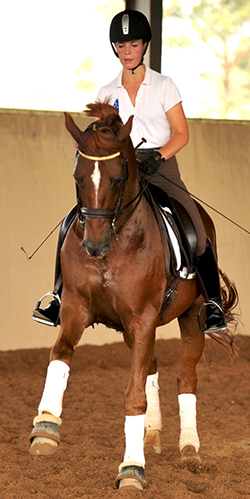
“Very good, long rein so that he balanced his body, so that it is not always up and down and up and down with the neck. Long rein, pat the horse. Very good. Next long side transition to trot without using the reins, just your body language. Change the rein and then the same procedure on the right hand. But this is the very first step you should do with this horse when you start a training session at home or when you prepare the horse for a competition. Please start this way.”
Razz is now stretching out and down of his own accord.
“And transition to canter. And on this long side, transition to trot. And now give the rein as long as possible.”
Razz is now hitting his hooves together.
“This noise, Robbie, shows us that he is not 100% balanced. The more he is balanced the less you will hear this clap, clap, clap, clapping. The more he uses his neck to balance the body, the less he will do this.”
Robbie entirely relinquishes her hold on the reins and Razz stretches and trots quietly.
story continues below the advertisement
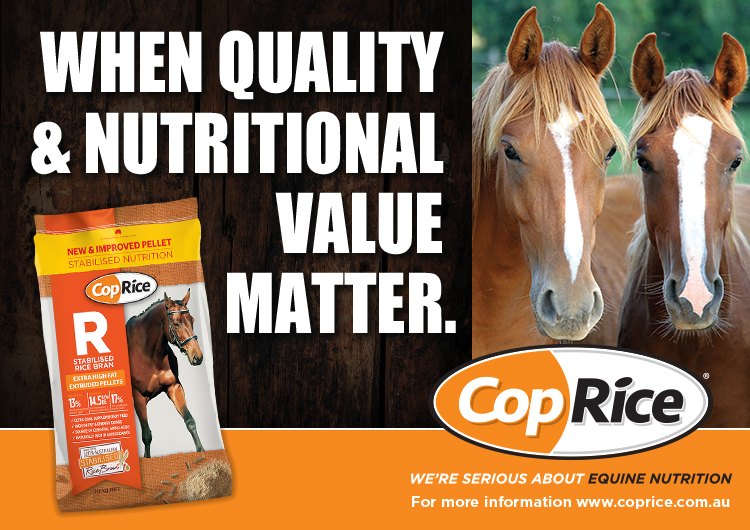
“I think it’s very good to ride the horse without reins because then you see and feel when the horse is really well balanced. Most riders help the horse too much and the result is that the horses are not balanced enough. So they do their job but with help – they lean on the bit and then the hands go up and so on. In the end the horse is using the bit more and more as a fifth leg, and this is not what we want. I think now, the first step is okay. He is relaxed and stretched.”
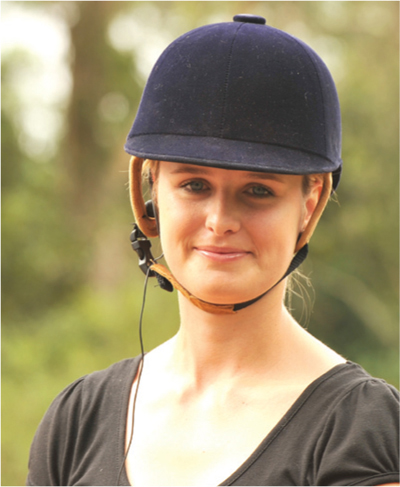
Jess Willard is from Quorrobolong in the Hunter Valley and is usually coached by Shaun France on her Arabian Warmblood, Sienna Tailor Made. She had her own set of challenges posed by Christoph, he took her stirrups away! While I was feeling sorry for Jess, her take on the situation was much more positive.
“It’s something I’ve been meaning to do for a long time. I just never get around to it at home.”
I called Jess a week after the clinic and…
“I’ve been riding without stirrups all week. Not on my young horse, that might not end so well, but with Tailor it’s really helping.”
And a couple of months down the track…
“Yep, I ride without stirrups once a week, I make myself do it now.”
In the SIEC indoor, without stirrups, things went something like this:
“Look around a little.” Jess had been instructed to move her upper torso from side to side. “Ja, so that you are a little bit flexible in your body and change the rein and the same procedure on the left rein, emphasising the bend to the inside. Be happy that you have a horse like him so that you can learn. Learn to be supple, have a good elasticity and now feel a little bit more with your inside leg. That’s correct, put your heels down so, good. That’s great, heels down and then a transition to trot please. Good.”
story continues below the advertisement
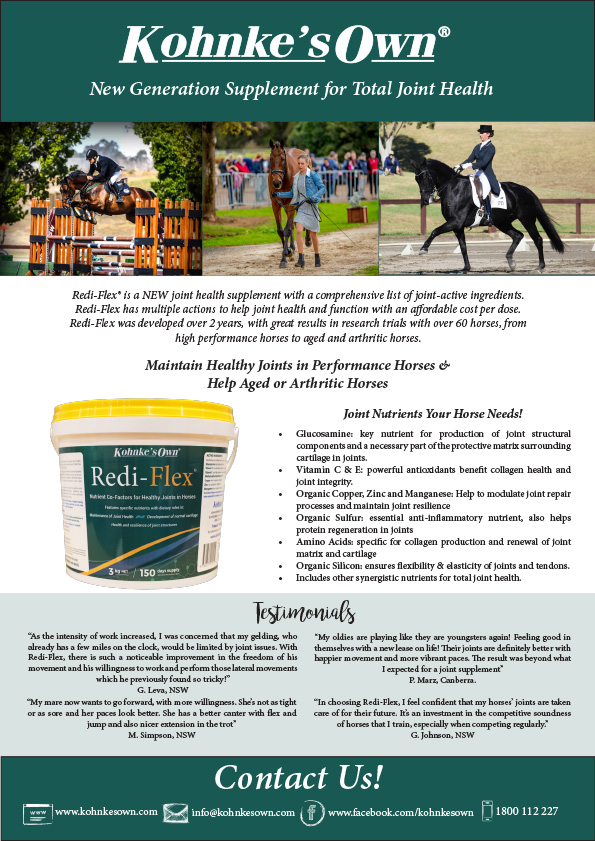
“Okay, no problem when the horse is running, you come with your inside leg and try to ride a little bit shoulder in tendency and then you can reduce the speed, coming with your inside leg a little bit, not using your reins. Yes, come with your inside leg – and both reins in the right hand.”
And Tailor canters…
“No problem. Well done, come with your inside leg again.”
Tailor seems a bit muddled and tests out whether it’s passage Jess is after.
“Not passage, use inside leg, more ground speed, good boy.”
Tailor stretches into the contact for a second before recoiling his neck again.
“So that he has confidence, use the inside leg. Good, pat him. So that he is absolutely familiar with your inside leg or otherwise he will always be short in the neck. Good, inside leg again, and Jess put your heels down so that you ride a little more with your heels and not your spurs. And pat the horse, and change the rein.”
“And we’ll do the same thing on the right hand. Stay on the circle and when you have a good feeling, take both reins in the left hand (the outside hand)and pat him. Use your inside leg enough. Pat him, and now transition to canter with both reins in one hand. Come on, pat him. Pat him behind the saddle as well. Balance your body in the saddle as much as possible. Now reins in both hands. He is a little bit confused but at the end he will be more happy. Super, now Jess, bring your hands in a good position.”
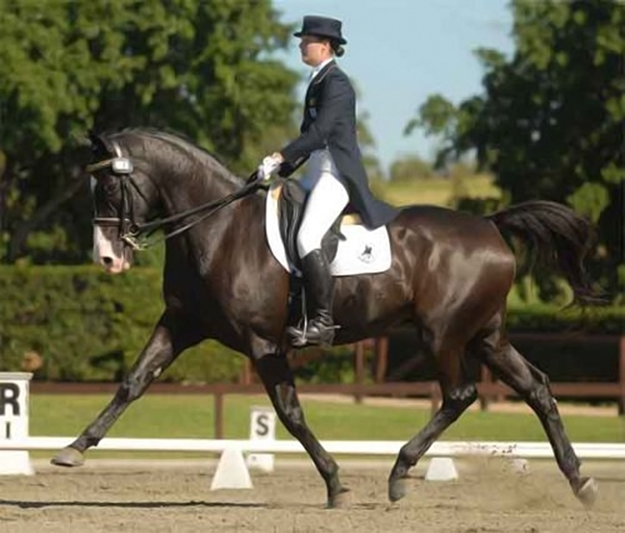
Jess and Tailor Made in competition mode
Making the horse happy sounds obvious when Christoph states it so matter-of-factly but it’s something I think most people forget easily. Excluding the post-Test slap around the neck, I’m not sure I remember the last time I saw a rider take his/her reins in one hand and giving the horse a whole-hearted pat to relax, comfort or reward it.
“Change the rein and flying changes, good, well done. Both reins in the outside hand. He becomes more and more happy. This is homework, nicht? Also it’s a super way to stabilise your position in the saddle and to help the horse. Give rein and re-take rein. And pat him and reins in both hands. Come with the inside leg and a little more soulder in on the circle. And both reins in the right hand and pat him. And shorter in the canter. Come with your inside leg. More inside leg, keep your heels down. That’s it, give both reins, and reins in both hands and then change the rein and flying change. A very good student, a very careful listener who tries to do a great job. You have improved a lot! Your position is much better. You start to help your horse with your position.”
Christoph then puts Jess to the test with one of his favourite exercises of the clinic:
“Circle and then serpentines three loops crossing the centreline with a flying change. Well done. Circle and again serpentines three loops. Bring your little fingers together. Circle and next time four loops. And now you do have a lot more influence in the saddle than before. Did you listen and watch the other lessons today? Because you made exactly the right decision. Super! And you’re making corrections with your position. Top class student. And now collect the horse with our position, and then serpentine, five loops, four flying changes.”
“A very good learning horses, easy in the flying changes. Open up the circle with a little bit medium canter with shoulder in tendency. Very good and both reins in the right hand and pat the horse.”
“Next long side shoulder in. You don’t need a trainer – you listen well and then you know what to do. Then half pass left, give rein, give the inside rein. Very good. The next long side I’m sure you will ride shoulder in and then half pass to the right. At home he needs to be a little bit more round but a HUGE step forwards! Now ride with your position and have a look to me (to get her eyes up). Super.”
Tailor is so much freer…
“Yesterday when I saw him I thought that is a good schoolmaster, but the more you ride him the more I think he looks like a good horse for competition. He loves the passage movements but I think today it is better to work this way.”
“Change the rein and then try to come to a little bit of a longer rein. Jess, fingers together and then come centimetre by centimetre and then a transition to walk. Usually you could now do rising trot but I think it’s enough otherwise you are stiff at the end.”

“What was the feeling? For me it was top! I didn’t expect it would be such a HUGE step forwards. Okay, so shorter stirrups and without stirrups. Often ride with one hand so that you are really balanced. Thank you very much for these two lovely rides. I will give you back the whip,” Christoph concludes.
For me, the essence of what was important about Christoph’s clinic was that his approach was holistic. Aspects of all lessons were inter-related and examples poignant. His lessons weren’t just about the horse or just about the rider, both were important. His lessons weren’t about getting the job done; teaching, learning and training were the focus. Christoph’s approach to tuition and judging dressage was always the same – a correct approach to the training scale in conjunction with safe and happy horses and riders.


